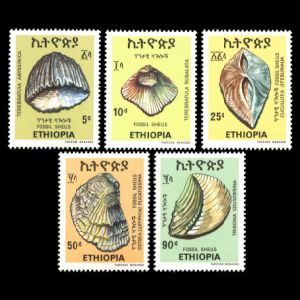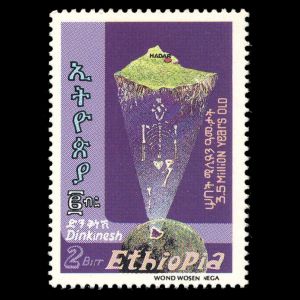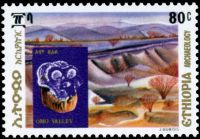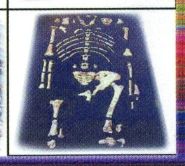the place where Paleontology and Paleoanthropology meets Philately
Ethiopia
Fossils of prehistoric animals and humans on stamps of Ethiopia
| << previous country | back to index | next country >> |
Contents:
- Country overview
- Philately of Ethiopia
- Official stamps of Ethiopia related to Paleontology and Paleoanthropology
- References
- Acknowledgements
Ethiopia, officially known as the Federal Democratic Republic of Ethiopia, is a country located in the Horn of Africa. It is bordered by Eritrea to the north and northeast, Djibouti and Somalia to the east, Sudan and South Sudan to the west, and Kenya to the south. With over 100 million inhabitants, Ethiopia is the most populous landlocked country in the world, as well as the second-most populous nation on the African continent after Nigeria. It occupies a total area of 1,100,000 square kilometers, and its capital and largest city is Addis Ababa.
Some of the oldest evidence for anatomically modern humans has been found in Ethiopia, which is widely considered the region from which Homo sapiens first set out for the Middle East and points beyond. According to linguists, the first Afroasiatic-speaking populations settled in the Horn region during the ensuing Neolithic era. [R1]
The first Ethiopian stamps were printed in Paris in 1894 and sold in Harar, Dire Dawa, Entoto, and Addis Ababa in 1895. The first souvenir sheet called "province Block", was designed and engraved by M. Eugene Mousson, the eminent French philatelic artist. There were seven denominations. Four of the stamps showed an effigy of Menelik II wearing his golden crown and the others show a stylized picture of a lion. When Ethiopia became a member of the Universal Postal Union in 1908, the occasion had been commemorated with the issuance of a new set of stamps that were also used for international mail until 1919. [R2]
To date, there is only one stamps set depicting some fossils of prehistoric animals (shells) issued in Ethiopia.
However, there are several stamps issues with prehistoric tools and fossils of human ancestors.
The most famous fossil of Ethiopia is fossil of Australopithecus skeleton, named Lucy[R3], who is commemorated on several stamps and postcards of the country.
Official stamps of Ethiopia related to Paleontology and Paleoanthropology: prehistoric shells, remains of prehistoric mankind
| 15.03.1977 "Archaeological Finds" [1] | 15.08.1977 "Fossil shells" | 04.07.1986 "Discovery of Hominid Skeleton" [2] |
 |
 |
 |
| 20.08.2013 "125th Anniversary of Addis Ababa" [2] | ||
 |
|
|
Notes:

|

|
|
Melka Kontoure prehistoric site and stone axe on stamp of Ethiopia 1978. MiNr.: 911 Scott: 825 |
Omo Valley, skull and hominid jawbone on stamp of Ethiopia 1978. MiNr.: 912 Scott: 826 |
Omo Valley and humanoid jawbone is shown on stamp with face value of 80C.
On the banks of the Omo River, archeologists have found fossil fragments of Olduwan hominids from the early Pleistocene era and up to the Pliocene era. This is an important site where the remains of several Australopithecus individuals were found.
[2] Fossil of Australopithecus skeleton, named Lucy shown on stamps from 1986 and on stamps with face value 4 of "125th Anniversary of Addis Ababa" set from 2013 (according to the date on bottom side if the stamps, printed in 2012, but released in 2013).

|
|
Australopithecus skeleton, named Lucy on stamp of Ethiopia 2013 MiNr.: 1918 Scott: 1872 |
Lucy was discovered in 1974 near the village of Hadar in the Awash Valley of the Afar Triangle in Ethiopia by paleoanthropologist Donald Johanson.
The Lucy specimen is an early Australopithecus and is dated to about 3.2 million years ago.
The skeleton presents a small skull akin to that of non-hominid apes, plus evidence of a walking-gait that was bipedal and upright, akin to that of humans (and other hominids); this combination supports the view of human evolution that bipedalism preceded increase in brain size. [R3]
References:
- [R1] Ethiopia: Wikipedia, WikiTravel, FlagCounter.
- [R2] Postal History and Philately of Ethiopia:
Ethiopian Post (official website),
Wikipedia,
Links to official website of the Post Authority, stamp catalog and a list of new stamps of Ethiopia are here. - [R3] Lucy (Australopithecus): Natural History Museum in London, BBC, Smithsonian Museum of Natural History, Wikipedia.
Acknowledgements:
Many thanks to Dr. Peter Voice from Department of Geological and Environmental Sciences, Western Michigan University, for reviewing the draft page and his very valuable comments.
| << previous country | back to index | next country >> |